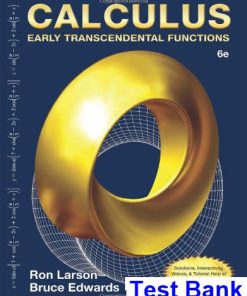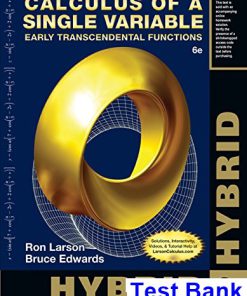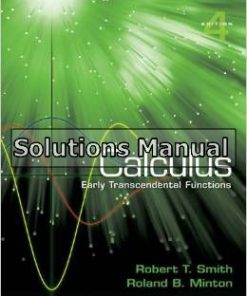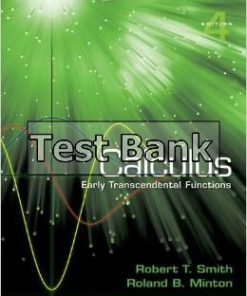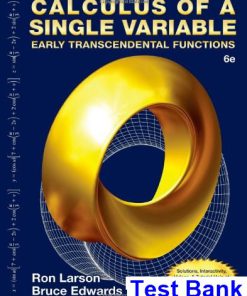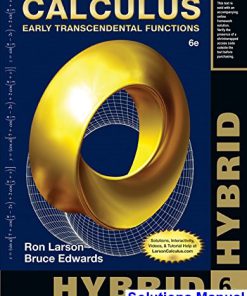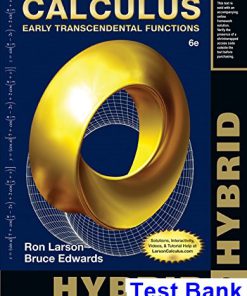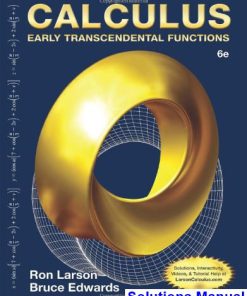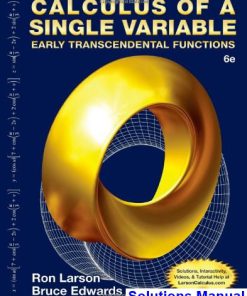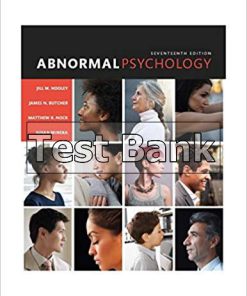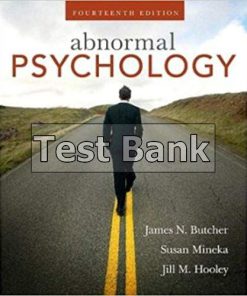Calculus Early Transcendental Functions 5th Edition Larson Test Bank
$50.00 Original price was: $50.00.$26.50Current price is: $26.50.
Calculus Early Transcendental Functions 5th Edition Larson Test Bank.
Calculus Early Transcendental Functions 5th Edition Larson Test Bank
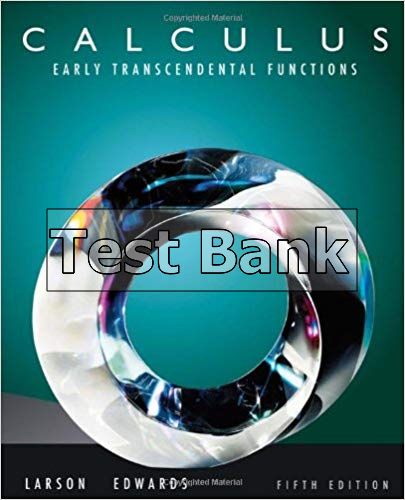
Product details:
- ISBN-10 : 0077166477
- ISBN-13 : 978-0077166472
- Author: Larson, Ron, Edwards, Bruce H.
The 5th edition of Calculus: Early Transcendental Functions maintains the critical components for which this calculus text is well known: facilitating mastery of prerequisite algebra and trigonometry skills, offering an elegant presentation of calculus concepts that is rigorous yet accessible, and including classic calculus problems such as applications for STEM and business disciplines.
Table contents:
- Chapter 1: Preparation for Calculus
- 1.1: Graphs and Models (48)
- 1.2: Linear Models and Rates of Change (59)
- 1.3: Functions and Their Graphs (51)
- 1.4: Fitting Models to Data (18)
- 1.5: Inverse Functions (43)
- 1.6: Exponential and Logarithmic Functions (40)
- Chapter 2: Limits and Their Properties
- 2.1: A Preview of Calculus (10)
- 2.2: Finding Limits Graphically and Numerically (47)
- 2.3: Evaluating Limits Analytically (65)
- 2.4: Continuity and One-Sided Limits (50)
- 2.5: Infinite Limits (48)
- Chapter 3: Differentiation
- 3.1: The Derivative and the Tangent Line Problem (52)
- 3.2: Basic Differentiation Rules and Rates of Change (61)
- 3.3: Product and Quotient Rules and Higher-Order Derivatives (55)
- 3.4: The Chain Rule (84)
- 3.5: Implicit Differentiation (58)
- 3.6: Derivatives of Inverse Functions (47)
- 3.7: Related Rates (44)
- 3.8: Newton’s Method (32)
- Chapter 4: Applications of Differentiation
- 4.1: Extrema on an Interval (48)
- 4.2: Rolle’s Theorem and the Mean Value Theorem (49)
- 4.3: Increasing and Decreasing Functions and the First Derivative Test (54)
- 4.4: Concavity and the Second Derivative Test (54)
- 4.5: Limits at Infinity (55)
- 4.6: A Summary of Curve Sketching (48)
- 4.7: Optimization Problems (53)
- 4.8: Differentials (46)
- Chapter 5: Integration
- 5.1: Antiderivatives and Indefinite Integration (78)
- 5.2: Area (64)
- 5.3: Riemann Sums and Definite Integrals (49)
- 5.4: The Fundamental Theorem of Calculus (85)
- 5.5: Integration by Substitution (70)
- 5.6: Numerical Integration (45)
- 5.7: The Natural Logarithmic Function: Integration (72)
- 5.8: Inverse Trigonometric Functions: Integration (67)
- 5.9: Hyperbolic Functions (78)
- Chapter 6: Differential Equations
- 6.1: Slope Fields and Euler’s Method (56)
- 6.2: Differential Equations: Growth and Decay (62)
- 6.3: Differential Equations: Separation of Variables (74)
- 6.4: The Logistic Equation (19)
- 6.5: First-Order Linear Differential Equations (55)
- 6.6: Predator-Prey Differential Equations (5)
- Chapter 7: Applications of Integration
- 7.1: Area of a Region Between Two Curves (63)
- 7.2: Volume: The Disk Method (50)
- 7.3: Volume: The Shell Method (39)
- 7.4: Arc Length and Surfaces of Revolution (45)
- 7.5: Work (27)
- 7.6: Moments, Centers of Mass, and Centroids (48)
- 7.7: Fluid Pressure and Fluid Force (14)
- Chapter 8: Integration Techniques, L’Hôpital’s Rule, and Improper Integrals
- 8.1: Basic Integration Rules (51)
- 8.2: Integration by Parts (61)
- 8.3: Trigonometric Integrals (42)
- 8.4: Trigonometric Substitution (49)
- 8.5: Partial Fractions (38)
- 8.6: Integration by Tables and Other Integration Techniques (49)
- 8.7: Indeterminate Forms and L’Hôpital’s Rule (62)
- 8.8: Improper Integrals (58)
- Chapter 9: Infinite Series
- 9.1: Sequences (42)
- 9.2: Series and Convergence (33)
- 9.3: The Integral Test and p-Series (32)
- 9.4: Comparisons of Series (27)
- 9.5: Alternating Series (34)
- 9.6: The Ratio and Root Tests (33)
- 9.7: Taylor Polynomials and Approximations (27)
- 9.8: Power Series (30)
- 9.9: Representation of Functions by Power Series (27)
- 9.10: Taylor and Maclaurin Series (33)
- Chapter 10: Conics, Parametric Equations, and Polar Coordinates
- 10.1: Conics and Calculus (42)
- 10.2: Plane Curves and Parametric Equations (35)
- 10.3: Parametric Equations and Calculus (47)
- 10.4: Polar Coordinates and Polar Graphs (48)
- 10.5: Area and Arc Length in Polar Coordinates (42)
- 10.6: Polar Equations of Conics and Kepler’s Laws (33)
- Chapter 11: Vectors and the Geometry of Space
- 11.1: Vectors in the Plane (40)
- 11.2: Space Coordinates and Vectors in Space (47)
- 11.3: The Dot Product of Two Vectors (44)
- 11.4: The Cross Product of Two Vectors in Space (33)
- 11.5: Lines and Planes in Space (51)
- 11.6: Surfaces in Space (33)
- 11.7: Cylindrical and Spherical Coordinates (47)
- Chapter 12: Vector-Valued Functions
- 12.1: Vector-Valued Functions (35)
- 12.2: Differentiation and Integration of Vector-Valued Functions (33)
- 12.3: Velocity and Acceleration (34)
- 12.4: Tangent Vectors and Normal Vectors (36)
- 12.5: Arc Length and Curvature (41)
- Chapter 13: Functions of Several Variables
- 13.1: Introduction to Functions of Several Variables (31)
- 13.2: Limits and Continuity (39)
- 13.3: Partial Derivatives (43)
- 13.4: Differentials (31)
- 13.5: Chain Rules for Functions of Several Variables (31)
- 13.6: Directional Derivatives and Gradients (36)
- 13.7: Tangent Planes and Normal Lines (33)
- 13.8: Extrema of Functions of Two Variables (37)
- 13.9: Applications of Extrema of Functions of Two Variables (35)
- 13.10: Lagrange Multipliers (32)
- Chapter 14: Multiple Integration
- 14.1: Iterated Integrals and Area in the Plane (46)
- 14.2: Double Integrals and Volume (43)
- 14.3: Change of Variables: Polar Coordinates (34)
- 14.4: Center of Mass and Moments of Inertia (33)
- 14.5: Surface Area (32)
- 14.6: Triple Integrals and Applications (32)
- 14.7: Triple Integrals in Cylindrical and Spherical Coordinates (32)
- 14.8: Change of Variables: Jacobians (33)
- Chapter 15: Vector Analysis
- 15.1: Vector Fields (33)
- 15.2: Line Integrals (35)
- 15.3: Conservative Vector Fields and Independence of Path (32)
- 15.4: Green’s Theorem (33)
- 15.5: Parametric Surfaces (33)
- 15.6: Surface Integrals (33)
- 15.7: Divergence Theorem (23)
- 15.8: Stoke’s Theorem (25)
- Chapter A: APPENDICES
- A.A. Proofs of Selected Theorems
- A.B. Integration Tables
- A.C. Precalculus Review
- A.D. Rotation and the General Second-Degree Equation (Online)
- A.E. Complex Numbers (Online)
- A.F. Business and Economic Applications (Online) (34)
- Chapter QP: Quick Prep Topics
- QP.1 Definition and Representations of Functions (14)
- QP.2 Working with Representations of Functions (14)
- QP.3 Function Notation (14)
- QP.4 Domain and Range of a Function (14)
- QP.5 Solving Linear Equations (14)
- QP.6 Linear Functions (17)
- QP.7 Parabolas (13)
- QP.8 Factoring Quadratic Equations and Finding x-intercepts of a Quadratic Function (14)
- QP.9 Polynomials (17)
- QP.10 More about Factoring Polynomials (14)
- QP.11 Finding Roots (14)
- QP.12 Dividing Polynomials (14)
- QP.13 Rational Functions (17)
- QP.14 Root Functions (17)
- QP.15 Rationalizing the Numerator or Denominator (12)
- QP.16 Exponential Functions (14)
- QP.17 Logarithmic Functions (17)
- QP.18 Trigonometric Functions and the Unit Circle (14)
- QP.19 Graphs of Trigonometric Functions (14)
- QP.20 Trigonometric Identities (17)
- QP.21 Special Functions (14)
- QP.22 Algebraic Combinations of Functions (14)
- QP.23 Composition of Functions (14)
- QP.24 Transformations of Functions (14)
- QP.25 Inverse Functions (17)
People also search:
smith (emea) calculus early transcendental functions 5th edition
calculus early transcendental functions 5th edition answers
|
calculus early transcendental functions 5th edition
calculus early transcendental functions 5th edition answer key pdf
calculus with early transcendental functions
larson calculus early transcendental functions
|
Instant download after Payment is complete
You may also like…
Calculus and Mathematics
Calculus Early Transcendental Functions 6th Edition Larson Test Bank
Calculus and Mathematics
Calculus of a Single Variable Hybrid Early Transcendental Functions 6th Edition Larso Test Bank
Calculus and Mathematics
Calculus of a Single Variable Early Transcendental Functions 6th Edition Larson Test Bank
Calculus and Mathematics
Calculus Hybrid Early Transcendental Functions 6th Edition Larson Solutions Manual
Calculus and Mathematics
Calculus Hybrid Early Transcendental Functions 6th Edition Larson Test Bank
Calculus and Mathematics
Calculus Early Transcendental Functions 6th Edition Larson Solutions Manual
Calculus and Mathematics
Calculus of a Single Variable Early Transcendental Functions 6th Edition Larson Solutions Manual




